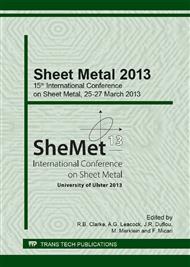[1]
Schuh, G., Monostori, L., Csaji, B. C., Döring, S.: Complexity-based modeling of reconfigurable collaborations in production industry, In: Annals of the CIRP, Vol. 57 , No. 1, 2008, pp.445-450.
DOI: 10.1016/j.cirp.2008.03.013
Google Scholar
[2]
Abele, E., Liebeck, T., Wörn, A.: Measuring Flexibility in Investment Decision for Manufacturing Systems', In: Annals of the CIRP, Vol. 55, No. 1, 2006, pp.433-440.
DOI: 10.1016/s0007-8506(07)60452-1
Google Scholar
[3]
da Silveira, G.J.C., Borenstein, D., Fogliatto, F.S.: The mass customization decade: An updated review of the literature, In: International Journal of Production Economics, Volume 138, Issue 1, July 2012, pp.14-25
DOI: 10.1016/j.ijpe.2012.03.002
Google Scholar
[4]
Kitazawa, K.: Incremental Sheet Metal Stretching-Expanding With CNC Machine Tools, Advanced Technology of Plasticity, (1993)
Google Scholar
[5]
Taleb Araghi, B., Bambach, M., Hirt, G., Zettler, J.: Investigations into the Process Mechanics of the Hybrid Process Combination of Stretch Forming and Incremental Sheet Forming, In: steel research international, Special Edition: 10th International Conference on Technology of Plasticity, 2011, pp.519-524
DOI: 10.1016/j.cirp.2009.03.101
Google Scholar
[6]
Asnafi, N.: On stretch and shrink flanging of sheet aluminium by fluid forming; Journal of Materials Processing Technology, vol. 96, 1999, pp.198-214
DOI: 10.1016/s0924-0136(99)00352-0
Google Scholar
[7]
Livatyali, H.; Müderrisoglu, A.; Ahmetoglu, M.A.; Akgerman, N.; Kinzel, G.L.; Altan, T.: Improvement of hem quality by optimizing operations using computer aided die design; CIRP Journal of Materials Processing Technology, vol. 98, 2000, p.41 – 52
DOI: 10.1016/s0924-0136(99)00304-0
Google Scholar
[8]
Kumagai, T.; Hiroyuki, S.; Meng, Y.: Hole flanging with ironing of two-ply thick sheet metals; Journal of Materials Processing Technology, vol. 98-90, 1999, pp.51-57
DOI: 10.1016/s0924-0136(99)00025-4
Google Scholar
[9]
Doege, E., Behrens, B.-A.: Handbuch Umformtechnik. Springer-Verlag Berlin Heidelberg. 2010, pp.384-390
Google Scholar
[10]
Dudra, S.; Shah, S. Stretch Flanges: Formability and Trimline Development. J. Materials Shaping Technology, 1988, 91–101
DOI: 10.1007/bf02834824
Google Scholar
[11]
Livatyali, H., Larris, S.J.: Experimental investigation on forming defects in flat surface–convex edge hemming: roll, recoil and warp. Journal of Materials Processing Technology, Volumes 153–154, 2004, pp.913-919
DOI: 10.1016/j.jmatprotec.2004.04.425
Google Scholar
[12]
Bambach, M. et al. (2009), Strategies to improve the geometric accuracy in asymmetric single point incremental forming, Production Engineering, vol. 3, pp.145-156.
DOI: 10.1007/s11740-009-0150-8
Google Scholar
[13]
Kreimeier, D., Buff, B., Magnus, C., Smukala, V., Zhu, J.: Robot-Based Incremental Sheet Metal Forming – Increasing the Geometrical Accuracy of Complex Parts, International Conference on Sheet Metal, 14, in: Key Engineering Materials, vol. 473, 2011, pp.853-860
DOI: 10.4028/www.scientific.net/kem.473.853
Google Scholar
[14]
Bambach, M.; Hirt, G.: Analysis and modeling of the extended forming limits in incremental sheet forming, International Conference on Technology of Plasticity (ICTP), 2008, p.682 ff.
Google Scholar
[15]
Voswinckel1, H., Schleifenbaum, H., Bambach, M., Hirt, G.: Design for manufacture based on an integrated product process design model, International Conference on Sheet Metal, 14, in: Key Engineering Materials, vol. 473, 2011, pp.799-806
DOI: 10.4028/www.scientific.net/kem.473.799
Google Scholar
[16]
Bambach, M. (2008).: Process strategies and modelling approaches for asymmetric incremental sheet forming, Umformtechnische Schriften Band 139, Shaker Verlag, Aachen.
Google Scholar
[18]
Taleb-Araghi, B., Manco, G., Bambach, M., Hirt, G.: Investigation into a new hybrid forming process: Incremental sheet forming combined with stretch forming, CIRP Annals, 58-1, 2009, pp.225-228.
DOI: 10.1016/j.cirp.2009.03.101
Google Scholar


